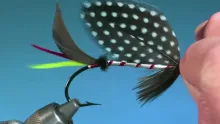I have always been fascinated by Spey and Dee flies.
Updated or edited 9 months ago
I have always been fascinated by Spey and Dee flies.
Sure, full dressed salmon flies are fascinating and beautiful, but the often lightly dressed Dee and Spey flies with their long and swung back hackles and low riding wings are just soooo fishy!
They all look like something, which could dig themselves perfectly into the jaw of a large Atlantic salmon.
At the same time they have the aura of the classics and you know that these patterns have fished all the great salmon waters of the world during all the great eras of salmon fishing.
And I know I'm not the only one who has this veneration.
Numerous books, show appearances, fly boxes and magazines have proved to me that many, many fly tiers around the world share my fascination.
Oregon based fly angler, outdoors author and photographer John Shewey is obviously one of them. He makes that quite clear in this book, which he has very correctly subtitled "History & Construction".
In the first part of the book he leads you through the fascinating history of these flies. He must have done a lot of research for this section, because the amount of detail is impressing and with photographs of new and old flies accompanied by historical facts and photos these twenty-and-some pages make up a perfect appetizer for the following more than one hundred pages.
The mainstay of the next part of the book is a thorough coverage of the materials needed for the flies, namely the hackles, which comprise a particular issue (not to say a problem) because many of the original descriptions require heron hackle.
Since this material is illegal in many countries, not least in the US, an extensive description of potential alternatives is called for. Shewey does a good job of this, and carries the style well into the chapters covering other materials used and from there gradually into techniques for bodies, hackles and wings.
After this general rundown of the materials and methods, the author treats the subjects of tying traditional and classic Spey and Dee flies. This very naturally leads to sections on the more contemporary flies. Still representing the classics, but with more recent origins, Syd Glasso, Dick Wentworth, Walt Johnson and Dave McNeese gets a whole chapter's worth attention - and well deserved too. Their renewal of the traditions has been of great importance and they have all been very influential.
From here you are led to the final chapter of the book, which will teach you how to tie the modern flies. In other words: the structure of the book is close to perfect, following the natural development of these particular styles of flies.
All the way through this journey Shewey has generously strewn the pages with great photos. I cannot find any photo credits, so I assume that the author has been behind the camera. No matter what the photographer has done a very good job! The pictures are on par with the best. You will find both artistic photos showing one or a few flies on "fancy" backgrounds as well as step-by-step photos of materials and many of the techniques and patterns.
Altogether this makes up a very inspiring book, which is bound to stir interest with both the tier who has already tied salmon flies as well as the novice who has not yet taken the bull by the horns.
The only thing I can find that is not quite as good as the rest is the layout. I would have loved to see this book laid out a bit more clean with classical typesetting rather than the modern heading, colored fonts combined with the oval images, which are a bit off in combination with the extremely stylish flies and photos.
Never the less it's an excellent book. Highly recommended.
PS: I think I'll tie some Spey flies this winter.
- Log in to post comments







